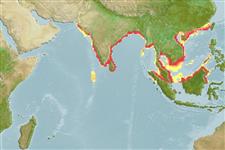>
Eupercaria/misc (Various families in series Eupercaria) >
Sciaenidae (Drums or croakers)
Etymology: Otolithoides: Greek, ous, oto = ear + Greek, lithos = stone + Greek, suffix, oides = similar to (Ref. 45335).
Environment: milieu / climate zone / depth range / distribution range
Ökologie
seewasser demersal; amphidrom (Ref. 51243). Tropical; 27°N - 1°N, 61°E - 120°E
Indo-West Pacific: Pakistan and along the coasts of India and Sri Lanka to the Malay Peninsula, Sumatra, Borneo and Viet Nam.
Size / Gewicht / Alter
Maturity: Lm ? range ? - ? cm
Max length : 160 cm SL Männchen/unbestimmt; (Ref. 9772); common length : 100.0 cm SL Männchen/unbestimmt; (Ref. 9772); max. veröff. Alter: 6 Jahre (Ref. 72458)
Kurzbeschreibung
Morphologie | Morphometrie
Rückenflossenstacheln (insgesamt): 9 - 10; Rückenflossenweichstrahlen (insgesamt): 27-32; Afterflossenstacheln 2; Afterflossenweichstrahlen: 6 - 7
Found in coastal and inshore waters. Feeds on small fishes and invertebrates. An important foodfish. Sold fresh and dried salted (swim bladder) in markets.
Life cycle and mating behavior
Geschlechtsreife | Fortpflanzung | Ablaichen | Eier | Fecundity | Larven
Lal Mohan, R.S., 1984. Sciaenidae. In W. Fischer and G. Bianchi (eds.) FAO species identification sheets for fishery purposes. Western Indian Ocean (Fishing Area 51). Vol. 4. FAO, Rome. pag. var. (Ref. 3490)
IUCN Rote Liste Status (Ref. 130435)
Bedrohung für Menschen
Harmless
Nutzung durch Menschen
Fischereien: weniger kommerziell
Mehr Information
NamenSynonymeMetabolismusRäuberÖkotoxikologieFortpflanzungGeschlechtsreifeAblaichenSpawning aggregationFecundityEierEientwicklung
ReferenzenAquakulturAquakultur ProfilZuchtlinienGenetikElectrophoresesVererbbarkeitKrankheitenVerarbeitungNutrientsMass conversion
PartnerBilderStamps, Coins Misc.LauteCiguateraGeschwindigkeitSchwimmstilKiemenoberflächeOtolithsGehirngrößeSehfähigkeit
Tools
Zusatzinformationen
Download XML
Internet Quellen
Estimates based on models
Preferred temperature (Ref.
123201): 24.8 - 29.3, mean 28.4 °C (based on 546 cells).
Phylogenetic diversity index (Ref.
82804): PD
50 = 0.7500 [Uniqueness, from 0.5 = low to 2.0 = high].
Bayesian length-weight: a=0.00676 (0.00449 - 0.01019), b=3.00 (2.88 - 3.12), in cm total length, based on LWR estimates for this species & (Sub)family-body (Ref.
93245).
Trophic level (Ref.
69278): 4.1 ±0.63 se; based on food items.
Widerstandsfähigkeit (Ref.
120179): mittel, Verdopplung der Population dauert 1,4 - 4,4 Jahre. (K=0.14-0.5; tmax=6).
Fishing Vulnerability (Ref.
59153): Moderate vulnerability (42 of 100).
Nutrients (Ref.
124155): Calcium = 81.6 [38.0, 170.5] mg/100g; Iron = 0.873 [0.409, 1.635] mg/100g; Protein = 19.1 [17.7, 20.4] %; Omega3 = 0.129 [0.061, 0.257] g/100g; Selenium = 103 [47, 228] μg/100g; VitaminA = 6.76 [2.01, 23.24] μg/100g; Zinc = 0.654 [0.435, 1.009] mg/100g (wet weight);
